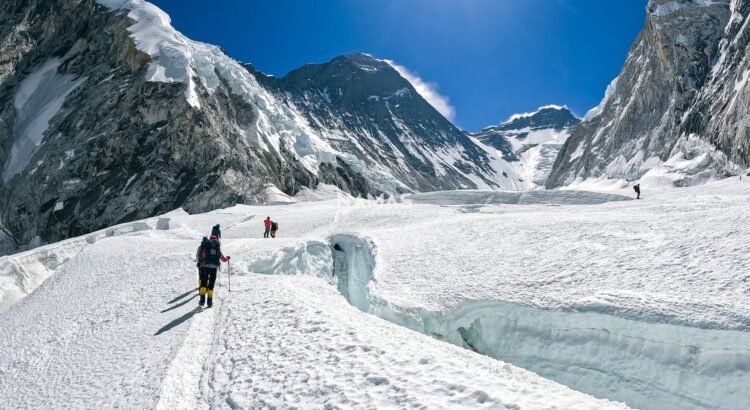
In the heart of the Himalayas lies a path that has captured the imagination of adventurers, trekkers, and dreamers for generations. The Everest Base Camp trail is not merely a physical journey through the world’s highest mountain range—it is a pilgrimage of the soul, a test of resilience, and a chance to discover the immense strength that lies within you.
From the first step in the bustling town of Lukla to the final approach at Everest Base Camp (5,364 meters or 17,598 feet), the trail demands effort, focus, and humility. But what it offers in return is far greater: awe-inspiring beauty, powerful self-realization, and a connection to a region steeped in spiritual and cultural significance.
The Journey Begins: Lukla To Namche Bazaar
Your trek begins with a dramatic flight into Lukla Airport, often considered one of the most thrilling landings in the world. Nestled between steep mountain ridges, the small airstrip sets the tone for an unforgettable adventure. From here, the trail winds through lush valleys, crossing swinging suspension bridges over roaring rivers, and passing through villages where yaks and prayer wheels are part of daily life.
The ascent to Namche Bazaar—the bustling Sherpa capital of the Khumbu region—is steep and challenging. As you climb, the air thins, and your pace slows. But with every step, the views become more breathtaking. Snow-capped peaks begin to appear in the distance, framed by forests of rhododendron and pine.
Namche is not only a resting point for acclimatization but also a cultural hub. Here, trekkers gather in cozy teahouses, share stories, and stock up on essentials. It’s also a time to reflect on how far you’ve come—and prepare for the even greater challenges ahead.
Climbing Higher: Tengboche, Dingboche, And Beyond
As you leave Namche behind, the real character of the trail reveals itself. With each passing day, the landscape transforms—trees give way to shrubs, and the jagged peaks of the Himalayas loom closer. The air grows colder, the paths narrower, and your body begins to feel the effects of high altitude.
One of the most spiritually significant stops on the trail is Tengboche Monastery. Perched at 3,867 meters (12,687 feet), this serene and sacred place offers panoramic views of Ama Dablam, one of the most beautiful mountains in the world. Trekkers often join monks for morning prayers, enveloped in the scent of incense and the deep resonance of chanting. It’s a humbling reminder of the spiritual heart of the Himalayas.
Continuing toward Dingboche and then Lobuche, you begin to feel the mental and physical strain. Simple tasks like tying your boots or lifting your backpack require greater effort. But it is in these moments of struggle that something extraordinary begins to happen—you start to recognize your own inner strength.
The Final Push: Gorak Shep To Everest Base Camp
The last leg of the journey is both exhilarating and exhausting. You reach Gorak Shep, the final settlement before Base Camp, and from there, set out on a rocky path across a glacial landscape. The terrain is uneven and harsh, but your determination fuels your steps.
Finally, you arrive at Everest Base Camp, a seemingly desolate, icy expanse that represents the gateway to the roof of the world. You stand in the shadow of Sagarmatha (Everest), not as a conqueror but as a humble traveler who has braved the elements, challenged the limits, and emerged stronger for it.
The feeling is indescribable—a mix of joy, relief, exhaustion, and awe. You didn’t climb to the summit, but you climbed your own mountain. And that makes all the difference.
Discovering Your Inner Strength
The Everest Trail is demanding, both physically and mentally. The altitude tests your lungs. The cold bites at your fingers. The long hours of hiking push your endurance. But in the process, you learn to listen to your body, pace yourself, and adapt.
You also learn to silence the inner critic—the voice that says, “You can’t do this.” Each time you take one more step, climb one more hill, or push through one more hour of fatigue, you prove that voice wrong.
In the stillness of the mountains, far from the noise of modern life, you begin to hear something else: your inner voice of resilience. It tells you that you’re stronger than you think, more capable than you imagined, and braver than you believed.
Trekking to Everest Base Camp isn’t about competition. It’s not about comparing your journey to others’. It’s about meeting yourself on the trail—unfiltered, raw, and real—and learning that the power to overcome lies within you.
The Beauty Around You
While the inner journey is profound, the outer landscape is equally mesmerizing. Every day offers new panoramas: the turquoise waters of glacial rivers, the towering white peaks of Lhotse, Nuptse, and Everest, and the deep gorges and hanging bridges that define the Khumbu region.
Wildlife, though elusive, adds to the magic. Keep an eye out for Himalayan tahrs, musk deer, and even the rare snow leopard. Birds such as the Himalayan monal, with its iridescent feathers, are frequent companions on the trail.
The trail also weaves through quaint villages, where prayer flags flutter in the wind, mani stones are etched with sacred texts, and smiling children offer “Namaste” with innocent curiosity. These cultural encounters enrich the journey and remind you that this region, while remote, is deeply alive.
Cultural Immersion And Sherpa Hospitality
No Everest trek would be complete without acknowledging the Sherpa people, whose strength, warmth, and spirit make the journey possible. Whether it’s the guides who share their knowledge, the porters who carry heavy loads with quiet grace, or the teahouse hosts who prepare hot meals with love, the Sherpa community is the heart of the trail.
Their deep respect for nature, mountain deities, and hospitality toward visitors is both inspiring and humbling. Many trekkers leave with not just memories of landscapes, but deep connections to people whose lives are deeply intertwined with the mountain.
Spending time in their villages, learning about their traditions, and sharing meals with Sherpa families provides insight into a way of life that values community, resilience, and balance with nature.
Tips For Trekking To Everest Base Camp
If you’re considering taking on this life-changing adventure, preparation is key:
- Train in advance: Build endurance with hikes, stair climbing, and cardio.
- Acclimatize properly: Take rest days and ascend gradually to avoid altitude sickness.
- Stay hydrated and eat well: Fuel your body with water and local dishes like dal bhat.
- Pack smart: Layered clothing, good boots, a sleeping bag, and a headlamp are essentials.
- Go with experienced guides: Local trekking companies often provide the best safety and cultural insight.
And most importantly, listen to your body and respect the mountain.
Returning Home Transformed
Coming down from the Everest trail is not the same as returning from an ordinary trip. The mountains leave a mark—not just on your legs or your lungs, but on your heart and mind.
You return with a different perspective. Challenges that once seemed big now feel manageable. The daily noise of life fades in comparison to the stillness you found among the peaks. You realize that the greatest summit you reached was not a place on the map, but a state of mind—one that knows perseverance, presence, and quiet strength.
Whether you’re an experienced hiker or someone seeking a personal milestone, the Everest trail offers something rare in today’s fast-paced world: clarity, purpose, and a renewed belief in yourself.
Final Reflections
To walk the Everest trail is to embark on a journey that stretches far beyond the borders of Nepal. It is a journey inward, through fear and fatigue, through beauty and wonder, toward the unshakable core of your being.
In every aching muscle and every breathtaking vista, in every warm cup of tea and every silent snowfall, you find pieces of yourself you didn’t know were there. And when you stand at Everest Base Camp, looking up at the highest point on Earth, you understand something simple and profound:
The real summit lies within.
So, challenge yourself. Step onto the trail. Trust your legs. Trust your spirit. And discover what you’re truly made of—one step, one breath, and one mountain at a time.




